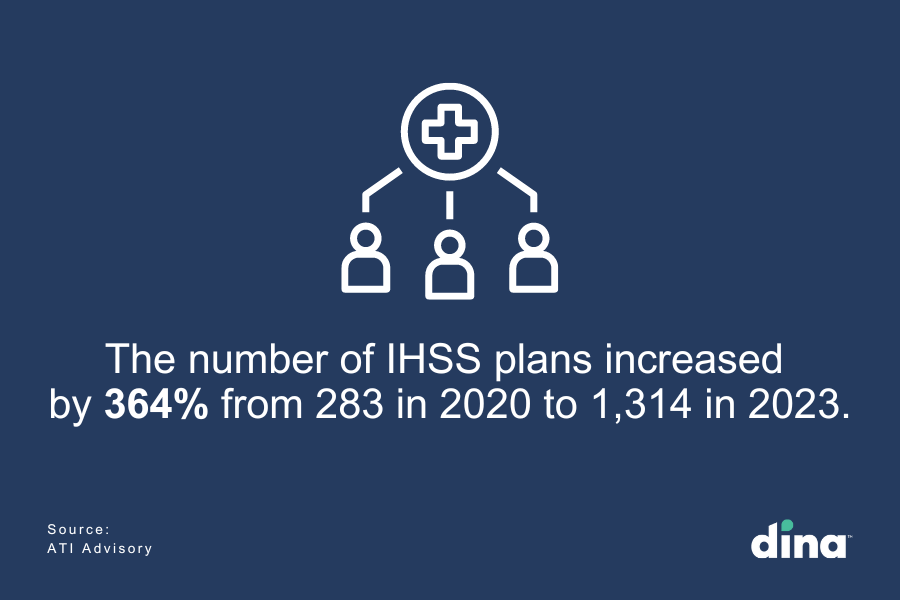
Since CMS began allowing Medicare Advantage (MA) plans to offer supplemental benefits, the popularity of those benefits has taken off. In just three years, the number of plans offering In-Home Support Services (IHSS) has skyrocketed by 364%, and plans with caregiver support service offerings increased 320%.
According to ATI Advisory, large health plans have rapidly expanded their in-home services coverage. Smaller plans that have never offered such services have begun doing so. According to the report, in-home benefits are provided by health plans to address gaps in the traditional healthcare system. These benefits are often offered as part of a flexible package designed to support individual member needs and overall health. In addition to meeting those needs, many plans find that these benefits promote satisfaction and retention among their members.
What are In-Home Support Services?
IHSS provide care and assistance to members who could benefit from support with their activities of daily living (ADLs). That includes those with physical or mental disabilities and oftentimes seniors who desire to age in place. As such, the services are usually offered in a member’s home rather than a long-term care or rehabilitation facility. The convenience saves the member time and energy while allowing for more individualized attention.
The services that can be approved through IHSS encompass a range of tasks including house cleaning, meal preparation, household chores (such as helping with laundry and groceries), personal care (such as assistance with bathing and grooming), accompanying members to doctor visits, and providing protective supervision for those with mental impairments. Services may even include specialized treatments like wound care or medication administration by skilled nurses.
What are the Benefits of IHSS?
The Agency for Healthcare Research and Quality reported that home visits reduce all-cause hospital admissions for patients with chronic heart failure following an associated inpatient stay. This finding suggests that the presence of a supporting team in a patient’s home can reduce the risk of a heart-failure patient returning to the hospital within 30 days. Another interpretation is that the visit itself confers benefits to the patient that standard metrics cannot measure.
Additional references suggest that members may derive additional benefits from home health aides who visit to help with daily tasks like bathing, shaving, and getting dressed. The boost in self-esteem and the feeling of being cared for may improve an individual’s overall well-being. Through such interactions and various other means, access to IHSS can help many people successfully age in place and stay well-cared for in their homes and communities.
MA plans have a unique opportunity to leverage the IHSS benefit to improve member satisfaction. Here are five key steps that MA plans can take to optimize the utilization of IHSS and deliver exceptional in-home care to their members.
5 Steps to Improve Utilization
1. Identify Eligible Members To effectively utilize IHSS, MA plans must identify eligible members based on their health, lifestyles, and specific needs. By evaluating factors such as instrumental activities of daily living (IADLs), plans can accurately determine which members can benefit from IHSS services. This targeted approach ensures that resources are allocated where they are most needed.
2. Match Service Agencies with Members MA plans should establish partnerships with qualified home care agencies and individual caregivers who meet the highest standards in licensing, training, credentialing, and quality. By carefully vetting these agencies, plans can guarantee that their members receive excellent in-home care. The assurance of reliable and reputable service providers fosters trust and confidence among members, leading to increased satisfaction with the care received.
3. Individualize Care Plans To deliver person-centered care, MA plans should work closely with home care agencies or individual caregivers to develop individualized care plans for each member receiving IHSS benefits. These care plans should be based on comprehensive assessments of the member’s needs and preferences. Regular reviews and updates ensure that the care provided remains aligned with the member’s evolving requirements.
4. Improve Collaboration Among Care Providers MA plans can optimize member satisfaction by promoting collaboration and information sharing among care providers involved in the member’s overall healthcare journey. By establishing strong connections with other healthcare providers, MA plans to ensure that crucial information about the member’s health status and treatment plans is communicated effectively.
5. Collect and Analyze Data To continuously monitor the quality of care provided, MA plans should collect and analyze relevant data. Regular assessments of the member’s health status and care plan, as well as monitoring caregiver performance and member satisfaction, allow plans to identify areas for improvement. By leveraging data-driven insights, MA plans can proactively address any gaps or concerns to optimize the effectiveness of IHSS benefits.
By leveraging the potential of IHSS, MA plans can establish themselves as trusted partners in their members’ health and well-being, filling any gaps in care and ensuring that individuals receive the support they need in the comfort of their own homes.





